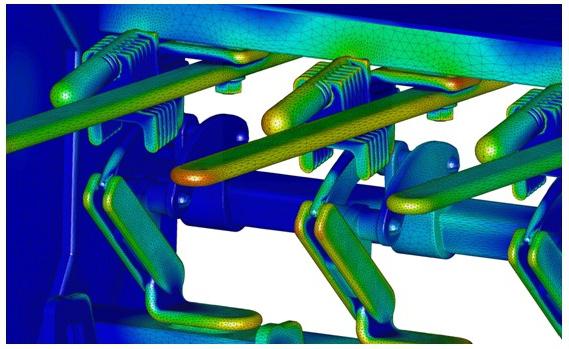The gas-insulated switch is a switching device that is widely used in electrical installations with a voltage class from 6 to 220 kV. An electric gas (SF6) acts as an arcing and insulating medium for the device. It is a chemically inactive, harmless, non-combustible gas that has excellent thermal conductivity and electrical strength.
The advantages of electric gas include the fact that it does not require, like
transformer oil, care, does not have a destructive effect on the design of the apparatus (under normal operation), does not age, and, moreover, is relatively inexpensive.
The SF6 circuit breaker has an arcing device, which is characterized by simplicity of design, as well as small overall dimensions. Arc extinction occurs with a small number of breaks and quite quickly. Now we will consider, according to what principle, the extinction of the arc in the apparatus and its design features occur. The gas-insulated switch contains three poles. Each of them is a metal hermetic reservoir, which is filled with SF6 gas compressed under pressure of 0.6 MPa. At each pole is an autopneumatic device designed to extinguish an arc.
Advantages of SF6 circuit breakers:
- the possibility of operation in electrical installations of open and closed execution of all voltage classes;
- reliability and simplicity of design;
- a large switching resource contact system;
- good breaking capacity;
- high level of response;
- fire and explosion safety;
- small weight and overall dimensions.
Switch SF6 gas has several disadvantages:
- high demands on the quality of electric gas;
- the use of special equipment, which is necessary for periodic maintenance of switching devices;
- during the operation of the device, harmful substances are formed for the human body - fluorides.
However, despite these drawbacks, circuit breakers of this type create serious competition for oil and air switching devices.

SF6-type devices are designed to operate in very difficult weather and environmental conditions. For example, SF6 circuit breakers (110 kV) can operate at ambient temperatures from -35 to +40 degrees Celsius, can be installed at an altitude of more than a thousand meters above sea level. During the operation of such devices, cycles of turning off and on the device are carried out. When the circuit breaker is operated within the rated current value (2000 A), it is able to perform a tripping operation 6000 times, and in emergency mode, as a rule, a short circuit current passes through it, and the device is able to carry out only 400 tripping cycles. The SF6 circuit breaker (35 kV) has a rated current greater than that of devices rated for 110 kV, it is 3150 A, and the rated breaking current is 50 kA. These devices are designed for the largest tripping peak - 127.5 kA.
In conclusion, we add that air and oil circuit breakers are gradually giving way to SF6 and vacuum switching devices. This can be explained by the excellent arcing characteristics of the gas and vacuum, as well as the increased operational safety of such equipment.